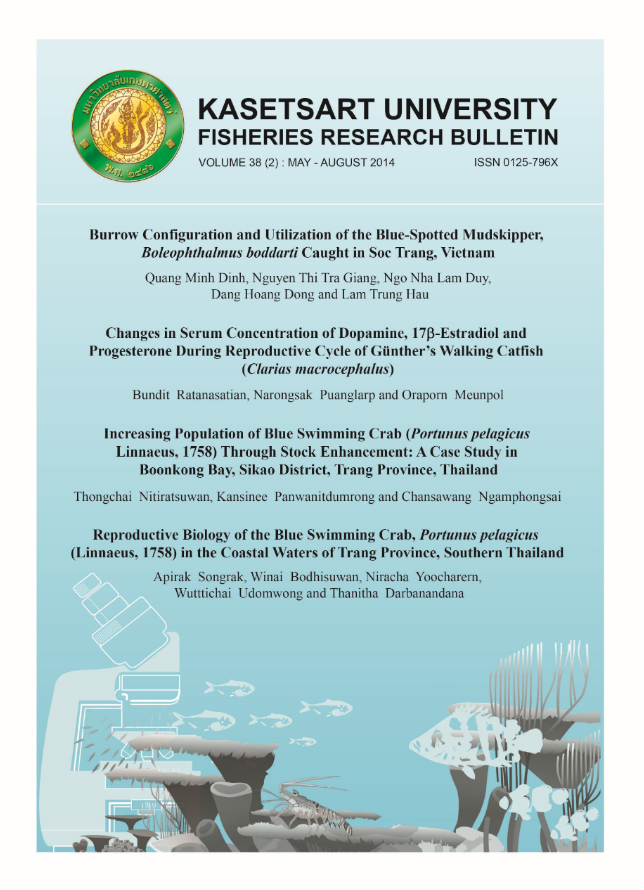Burrow Configuration and Utilization of the Blue-Spotted Mudskipper, Boleophthalmus boddarti Caught in Soc Trang, Vietnam
Main Article Content
Abstract
The blue-spotted mudskipper, Boleophthalmus boddarti, is an important commercial fish species found in coastlines and estuaries in the Mekong Delta. This amphibious, mudflat inhabitant fish can directly respire air at mud surface. Despite its high economic value, information on biology and ecology, especially burrow structure is scarce. This study was carried out in order to understand burrow morphology and utilization purpose. The study was conducted for six months, from February to July 2013 in the Mekong Delta at Cu Lao Dung, Soc Trang province, Vietnam. The structure of the blue-spotted mudskipper burrow was studied by using resin castings on burrows in situ technique. Burrow structure of this species comprised one to two openings with "footmarks" made by its pectoral fins with one to two bulbous chambers. In general, burrow shapes were "I" and "U" types with one to two slightly slanting tunnels attaching the chambers together with some short cul-de-sac side branches. Moreover, the burrow had no mound at the opening. Results revealed that burrow structures have a strong relationship with fish size. The blue-spotted mudskipper uses a burrow as a place for foraging prey, living, refuge from predators, and spawning.
Article Details
References
2. Atkinson R.J.A., C.J. Chapman. 1984. Resin casting: a technique for investigating burrows in sublittoral sediments. Progress in Underwater Science 10, 109-115.
3. Atkinson R.J.A., A.C. Taylor. Burrows and burrowing behaviour of fish. In: Meadows P.S., A. Meadows (eds) The environmental impact of burrowing animals and animal burrows, Zooological Society of London, 1991. Clarendon Press Oxford, pp 133-155.
4. Bhatt N.Y., S.J. Patel, D.A. Patel, H.P. Patel. 2009. Burrowing activities of goby fish in the recent intertidal mud flats along the Navinal coast, Kachchh, Western India. Journal of the Geological Sociaty of India 74 (4):515-530.
5. Clayton D.A. 1993. Mudskippers. Oceanography and Marin e Biology: an annual review 31:507- 577.
6. Dinh T.D. 2008. Some aspects of biology and population dynamics of the Goby Pseudapocryptes elongatus (Cuvier, 1816) in the Mekong Delta. PhD, Universiti Malaysia Teregganu, Malaysia.
7. Dinh T.D., S. Koichi, N.T. Phuong, H.P. Hung, T.X. Loi, M.V. Rieu, U. Kenzo. 2013. Fishes of Mekong Delta, Vietnam. Can Tho University publisher, Can Tho.
8. Froese R., D. Pauly (2013) FishBase. World Wide Web Electronic Publication. www.fishbase.org. Accessed 19/07/ 2013.
9. Gonzales T.T., M. Katoh, A. Ishimatsu. 2008. Intertidal burrows of the air-breathing eel goby, Odontamblyopus lacepedii (Gobiidae: Amblyopinae). Ichthyological Research 55 (3):303-306.
10. Ishimatsu A., Y. Hishida, T. Takita, T. Kanda, S. Oikawa, T. Takeda, K.K. Huat. 1998. Mudskippers store air in their burrows. Nature 391 (6664):237-238.
11. Ishimatsu A., T. Takeda, Y. Tsuhako, T.T. Gonzales, K.H. Khoo. 2009. Direct evidence for aerial egg deposition in the burrows of the Malaysian mudskipper, Periophthalmodon schlosseri. lchthyological Research 56 (4):417-420.
12. Ishimatsu A., Y. Yoshida, N. Itoki, T. Takeda, H.J. Le e, J.B. Graham. 2007. Mudskippers brood their eggs in air but submerge them for hatching. The Journal of Experimental Biology 210 (22):3946-3954.
13. Itani G., T. Uchino. 2003. Burrow morphology of the goby Taenioides cirratus. Journal of the Marine Biological Association of the United Kingdom 83 (4):881-882.
14. Mazzoldi C., M. Scaggiante, E. Ambrosin, M.B. Rasotto. 2000. Mating system and alternative male mating tactics in the grass goby Zosterisessor ophiocephalus (Teleostei: Gobiidae). Marine Biology 137 (5):1041-1048.
15. Ravi V. 2013. Food and Feeding Habits of the Mudskipper,Boleophthalmus boddarti (Pallas, 1770) from Pichavaram Mangroves, Southeast Coast of India. International Journal of Marine Science 3 (12):98-104.
16. Takegaki T. 2001. Environmental factors affecting the spawning burrow selection by the gobiid Valenciennea longipinnis. Journal of Fish Biology 58 (1):222-229.
17. Takegaki T.,A. Nakazono. 1999. Reproductive behavior and mate fidelity in the monogamous goby, Valenciennea longipinnis. Ichthyological Research 46 (2):115-123.
18. Vesey G. & T.E. Langford. 1985. The biology of the black goby, Gobius niger L. in an English south coast bay.Journal of fish biology, vol. 27, no. 4, 417-29.


